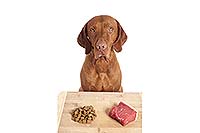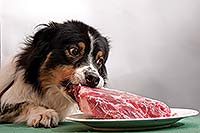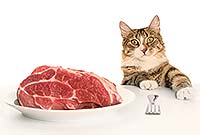Last month’s article discussed the carnivorous nature of dogs and cats, and how their bodies are very expertly designed to thrive on a diet of animal protein. This month’s article outlines exactly why animal protein is so crucial to the health of cats and dogs, and why a plant-based diet is not a species appropriate diet for your cat or dog.
Why Dogs Need Animal Protein
Dogs require 22 essential amino acids to handle all their metabolic and energy needs, but their bodies only produce 12 of the 22. The other 10 must come from the food they eat. Because the canine digestive tract is short and simple, it doesn’t produce the enormous amounts of amino acids that herbivores do, which is why your dog must obtain preformed amino acids directly from their diet. The protein you feed your dog should provide a wide spectrum of amino acids to meet their nutritional needs. The protein sources with wide-spectrum amino acid profiles include beef, bison, chicken, eggs, fish, lamb, rabbit, turkey, goat, venison, and elk.
Protein is a crucial component of every cell in your pet’s body. Essential amino acids from high-quality animal protein build healthy cells, organs, and muscles, and provide necessary enzymes and hormones as well. The fat in your dog’s diet aids in the absorption of certain vitamins, and provides energy and essential fatty acids. Fatty acids from animal sources are important for healing, normal cell membrane synthesis, reproduction, and a healthy coat and skin.
Why Cats Need Animal Protein
Cats are obligate carnivores. Obligate means “by necessity” or “by biologic requirement.” In other words, cats must eat meat to survive. The protein in animal tissue has a complete amino acid profile. Plant proteins do not contain all the amino acids critical for the health of obligate carnivores. Kitties have zero capacity to turn plant proteins into the missing pieces needed for a complete amino acid profile. One of the amino acids missing in plants is taurine, which is found in animal muscle meat, and in particular, the tissues of the heart and liver. Taurine deficiency causes serious health problems in cats, including cardiovascular disease and blindness.
Additional Considerations: Vitamin D, Essential Fatty Acids, and Protein Quality
Neither cats nor dogs make vitamin D in their skin from sunlight, so it also needs to come from their diet. The vitamin D needs to be vitamin D3 (which comes from animal sources), not vitamin D2 (which comes from plant-based sources). Dogs can use D2 to some extent, but cats cannot – they must have D3 in their diet. Unlike humans, dogs and cats lack the enzymes necessary to convert vegetable sources of omega-3 essential fatty acids like alpha-linolenic acid (ALA) into adequate amounts of docosahexaenoic acid (DHA) and eicosapentaenoic acid (EPA).
Dogs and cats on a vegetarian diet are deficient in both DHA and EPA, which leads to a number of inflammatory and degenerative issues down the line.
The quality of protein you feed your dog or cat is also very important. High-quality flesh meats are easier for pets to digest, absorb, and use properly. Avoid non-meat sources of protein for carnivores, including soy and corn, as not only are they not species appropriate, they’re also frequently genetically modified and treated with pesticides. Fat and protein in the diets of pet carnivores should come from ethically raised, whole food sources. In vegetarian and vegan diets for pets, the amino acids, vitamins, and minerals must be supplemented from synthetic sources, which are not ideal, because it’s not whole food.
The risks of feeding dogs and cats a vegetarian or vegan diet can include:
• Inadequate total protein intake
• Imbalances of certain amino acids such as taurine and l-carnitine
• Imbalances in essential fatty acids, in particular arachidonic acid for cats
• A deficiency in vitamins and minerals – such as the B vitamins, calcium, phosphorous, and iron – will also occur as these nutrients are obtained ideally or only through meat, bone and other animal products
These nutritional deficiencies and imbalances can ultimately lead to serious and sometimes irreversible medical conditions.
 Veterinary Community Is United in Refusing to Support Vegetarian or Vegan Diets for Dogs and Cats Veterinary Community Is United in Refusing to Support Vegetarian or Vegan Diets for Dogs and Cats
Occasionally, veterinarians will prescribe a vegan diet for a temporary allergy elimination dietary trial, if it goes on for just a month or two, it shouldn’t cause significant or permanent damage to an adult animal. If your vet is suspicious that your pet is sensitive to a particular type of protein, I suggest you consider completing an allergy test. The test results will highlight the foods your pet should avoid. Other than when attempting to identify food allergies, the vast majority of conventional and holistic veterinarians do not advocate or support feeding carnivores as vegetarians.
Many veterinarians have clients that say, “Well, I’ve been feeding my dog as a vegan for two years and she appears to be doing great.” A few years down the road, their dogs are being treated for preventable degenerative diseases, including Type 2 diabetes from too many carbohydrates, heart failure from lack of amino acids, and serious musculoskeletal problems from trace mineral nutritional deficiencies.
Bottom Line: Please Don’t Put Your Personal Beliefs Ahead of the Health of Your Pet
Pet owners who force their carnivorous companion animals to eat meat-free diets are placing their personal beliefs in a vegetarian or vegan lifestyle ahead of their pet’s physiologic requirement for a meat-based diet. I am sure there are some that do not like the term “force” to describe what pet guardians do when they choose to feed a dog or cat a non-meat based diet but to feed a carnivore a diet they wouldn’t choose for themselves is indeed forcing them to survive on a diet their body was not designed to process or thrive on.
This is really just about using common sense and keeping the best interests of your pet as your number one priority. If your personal eating habits or philosophy are so strong that everyone in your family must abide by them, I encourage you to pick a species to care for whose dietary needs are aligned with yours. If you’re a committed vegetarian or vegan and can’t stand the sight or even the thought of meat, choose a companion animal designed by nature as a vegetarian.
If your pet happens to be a rabbit and you’re all about the Paleo lifestyle, please don’t force your carnivorous habits onto your bunny. If your pet is a snake, don’t be angry when he turns down salad. You get the idea…
Pushing your personal nutritional philosophy on another species that doesn’t have the same biologic requirements as you do isn’t ethical.
|